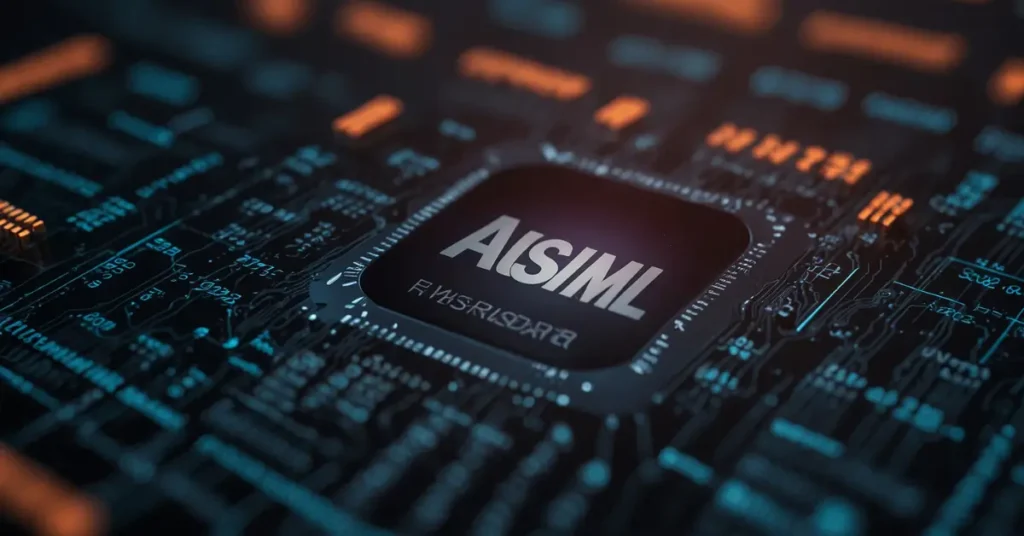Investor Jitters Amid Shifting Chip Market
This trend will directly influence the ASML 2026 growth outlook, especially as global chipmakers adjust to shifting demand and trade policies.
ASML 2026 growth outlook has drawn global attention as the Dutch semiconductor equipment giant warns of a possible decline in China sales heading into 2026. The company is now working to calm investor nerves amid shifting chip market conditions and ongoing U.S. export restrictions that continue to reshape the semiconductor industry.
As one of the world’s most vital suppliers of extreme ultraviolet (EUV) lithography machines, ASML plays a critical role in manufacturing advanced chips for artificial intelligence, smartphones, and data centers. However, with increasing geopolitical tensions and new restrictions limiting what technology it can sell to China, investors are now watching closely to see if the company can sustain its ambitious 2026 growth forecast.
ASML’s Dominance in the Global Semiconductor Industry
Understanding the ASML 2026 growth outlook also requires looking at its dominance in chipmaking technology.
ASML is not just another chip company — it is the only manufacturer in the world capable of producing EUV lithography machines, the cutting-edge equipment used to print microscopic transistors on advanced semiconductor chips. These machines, which cost over $150 million each, are essential to producing the most powerful chips used by companies like TSMC, Samsung, and Intel.
This dominance has made ASML a cornerstone of the global semiconductor industry, and any hint of slowdown can ripple across the entire tech ecosystem. Over the last few years, the company’s growth has been fueled by a surge in demand from AI-driven chipmakers, but now, China’s declining orders and export limitations are threatening to slow that momentum.
China has been one of ASML’s most lucrative markets, accounting for nearly 25% of its total revenue in recent quarters. With recent restrictions on advanced chip exports, that figure is expected to shrink considerably, forcing ASML to look for growth elsewhere — particularly in the United States, Taiwan, and South Korea.
China Sales Decline: The Growing Impact of Export Restrictions
The ASML 2026 growth outlook may depend heavily on how quickly the company offsets its reduced China revenue through global diversification.
ASML’s warning about weaker sales in China is not surprising, but it carries significant implications. The U.S. government has tightened export controls to prevent China from accessing the most advanced chipmaking equipment, and ASML — a European company — is caught in the middle of this geopolitical crossfire.
The restrictions prevent ASML from selling its most advanced EUV systems and some of its deep ultraviolet (DUV) equipment to Chinese firms involved in high-end chipmaking. As a result, orders from Chinese chip manufacturers have slowed, creating short-term pressure on ASML’s financial performance.
However, ASML executives have emphasized that the company remains resilient. According to the firm, “Our long-term growth prospects are intact. While China sales may decline in the short term, the overall demand for advanced chips is expected to grow globally.”
This statement reflects ASML’s belief that global semiconductor expansion, particularly driven by AI, cloud computing, and automotive technology, will help offset the decline from China.
ASML’s 2026 Growth Forecast: Reassuring Investors
Despite the challenges, ASML’s 2026 growth outlook remains strong, supported by AI-driven chip demand and fab expansions.The company expects to maintain solid revenue growth, driven by rising investments in semiconductor fabrication plants (fabs) and the ongoing digital transformation across industries.
In its latest investor briefing, ASML highlighted several key factors supporting this optimism:
- Rising Demand for AI Chips:
AI technologies require high-performance processors built on advanced semiconductor nodes, and ASML’s EUV machines are central to that production. - Global Fab Expansions:
Companies like Intel, TSMC, and Samsung are expanding manufacturing capacity in the U.S., Japan, and Europe — all markets accessible to ASML without export restrictions. - Diversification Beyond China:
While China’s demand may soften, ASML is rapidly increasing sales in other regions, particularly as governments encourage domestic chip manufacturing under policies like the U.S. CHIPS Act and EU Chips Act. - Technological Leadership:
ASML continues to innovate with its next-generation EUV platform, known as High-NA EUV, which promises even more precise chip manufacturing for 2nm and beyond.
Peter Wennink, ASML’s CEO, assured investors that 2025–2026 would represent a period of stabilization after recent fluctuations, emphasizing that “the semiconductor industry remains cyclical, but our technology leadership positions us strongly for the next wave of growth.”
Impact on Global Chip Supply Chains
Analysts believe the ASML 2026 growth outlook could still remain positive, given the company’s essential role in advanced chip production.The ripple effects of ASML’s slowdown extend far beyond the Netherlands. The company’s machines are the backbone of chip production for nearly every major semiconductor manufacturer. Any disruption to its sales or production can affect the entire global chip supply chain.
For instance:
- TSMC relies on ASML equipment for producing the most advanced chips used in Apple devices and AI servers.
- Samsung Electronics uses ASML’s EUV systems for its next-generation smartphone and memory chips.
- Intel depends on ASML to regain technological leadership in advanced chip manufacturing in the U.S.
A reduction in ASML’s China shipments could also impact global chip prices, as Chinese firms attempt to source older or less advanced equipment, potentially widening the technology gap between China and the West.
However, analysts believe that this could ultimately benefit ASML in the long run. By focusing on markets with stable political relationships and higher technological demands, the company could sustain healthy margins even if total sales volumes temporarily decline.
What Analysts Are Saying About ASML’s Outlook
Several reports have reaffirmed that the ASML 2026 growth outlook remains resilient despite short-term trade uncertainties.
- Bernstein Research recently noted that “ASML’s near-term China exposure remains a risk, but its technological moat ensures strong long-term growth potential.”
- Goldman Sachs analysts stated that “ASML is better positioned than most peers to navigate the geopolitical challenges due to its diversified customer base and unmatched EUV technology.”
- Meanwhile, Reuters reported that ASML is expected to see a “temporary revenue dip” in 2025, followed by a strong rebound in 2026 as global chip demand recovers.
In short, while 2025 might bring uncertainty, most experts agree that ASML’s strategic importance to global chipmaking will keep it in a dominant position for years to come.
ASML’s Strategy: Balancing Innovation and Stability
This strategy not only secures customer trust but also strengthens the ASML 2026 growth outlook for long-term investors.Asmara’s ability to reassure investors amid geopolitical pressure is rooted in its commitment to innovation and customer diversification. The company has continued investing heavily in research and development, spending billions annually to refine its EUV systems and develop new lithography tools.

Moreover, ASML’s partnerships with top chipmakers — such as TSMC, Intel, and Samsung — give it unparalleled insight into future technology needs. This close collaboration enables ASML to design equipment that matches the next generation of chip designs, ensuring it remains essential to its clients’ roadmaps.
The firm is also focusing on service-based revenue streams, offering maintenance, upgrades, and process optimization to existing customers — a move that stabilizes income even when new equipment sales slow.
Global Semiconductor Trends Supporting ASML
Each of these factors will likely support a positive ASML 2026 growth outlook as the industry moves toward next-gen chip production.
- AI and Data Center Boom:
The rise of AI-driven workloads and massive data processing needs require cutting-edge chips built with ASML’s equipment. - Automotive Digitization:
Electric and autonomous vehicles demand powerful processors, creating new growth opportunities in automotive chip production. - Reshoring of Chip Manufacturing:
Governments worldwide are incentivizing local semiconductor production, boosting demand for ASML machines outside China. - Next-Gen Lithography:
ASML’s High-NA EUV systems are expected to drive a new wave of orders from 2025 onward, as chipmakers move toward 2nm and 1.4nm nodes.
These trends collectively reinforce ASML’s role as the critical enabler of future digital economies, regardless of temporary geopolitical challenges.
Conclusion: Short-Term Pressures, Long-Term Strength
While short-term China pressures may continue, the ASML 2026 growth outlook remains stable thanks to innovation and diversification.
By diversifying its markets, leading in EUV technology, and focusing on stable, advanced economies, ASML is positioning itself to overcome short-term disruptions and emerge even stronger by 2026.
In the eyes of investors, the current challenges are temporary — but ASML’s technological edge remains unmatched. The company continues to hold the key to the semiconductor industry’s future, and as global demand for AI and advanced chips accelerates, ASML’s role will only become more vital.
Will ASML’s strategic pivot away from China strengthen its dominance in the global chip race? The next two years will provide the answer — but for now, the company seems determined to keep investor confidence intact and its innovation engine running at full speed.
FAQ Section
Q1: Why is ASML important in chipmaking?
ASML is the only company in the world that manufactures EUV lithography machines, essential for producing the most advanced semiconductor chips used in AI, smartphones, and computers.
Q2: How does China’s market affect ASML’s revenue?
China contributes nearly 25% of ASML’s total revenue. However, U.S. export restrictions are limiting sales of advanced equipment to Chinese chipmakers, leading to a potential decline.
Q3: What are ASML’s 2026 growth expectations?
ASML expects stable revenue growth by 2026, driven by rising global demand for advanced chips and expansion of semiconductor manufacturing outside China.
Q4: Will U.S. export restrictions continue to impact ASML?
Yes, restrictions will affect ASML’s China sales in the short term, but the company’s global diversification strategy and strong demand from other markets are expected to offset the loss.
Q5: What are ASML’s 2026 growth outlook expectations?
The company expects steady revenue supported by global chip demand.

